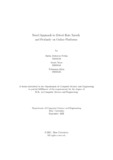| dc.contributor.advisor | Kabir, Md Rayhan | |
| dc.contributor.advisor | Sakeef, Nazmus | |
| dc.contributor.author | Pritha, Barha Meherun | |
| dc.contributor.author | Islam, Samin | |
| dc.contributor.author | Alam, Tabassum | |
| dc.date.accessioned | 2022-06-01T08:29:07Z | |
| dc.date.available | 2022-06-01T08:29:07Z | |
| dc.date.copyright | 2021 | |
| dc.date.issued | 2021-09 | |
| dc.identifier.other | ID 18101232 | |
| dc.identifier.other | ID 18101444 | |
| dc.identifier.other | ID 18101235 | |
| dc.identifier.uri | http://hdl.handle.net/10361/16801 | |
| dc.description | This thesis is submitted in partial fulfillment of the requirements for the degree of Bachelor of Science in Computer Science and Engineering, 2021. | en_US |
| dc.description | Cataloged from PDF version of thesis. | |
| dc.description | Includes bibliographical references (pages 29-30). | |
| dc.description.abstract | Hate speech is becoming more prominent and dominant in the virtual world, with
the popularity of social media increasing day by day. People nowadays have various
online platforms where they can express their hatred and write offensive speech in
the safety of their home. They could even spread false rumors and incite hatred
out of nothing. Cyberbullies often verbally attack the sentiments of people with
different race, nationality, gender, beliefs and political views. They could also target
young children and teenagers. It is also important to note that profane language
or some sensitive topic may be bothersome when reached in front of young children
and teenagers. It has become necessary for modern technology to detect all those
profane and hate speeches so that they can be filtered or removed automatically
before they can appear in front of young children or hurt the sentiments of targeted
people. However, even though it is easy to detect profanities, it could be difficult to
detect all the hate speeches which do not have any offensive or sensitive keywords. It
is possible to spot all sorts of hate speeches on social media through the application
of machine learning, neural networks and natural language processing. In our study,
to identify and recognize hate speeches we will use various models and algorithms.
Then we will design and implement an algorithm which will be able to detect hate
speech and profane language more efficiently. | en_US |
| dc.description.statementofresponsibility | Barha Meherun Pritha | |
| dc.description.statementofresponsibility | Samin Islam | |
| dc.description.statementofresponsibility | Tabassum Alam | |
| dc.format.extent | 30 pages | |
| dc.language.iso | es | en_US |
| dc.publisher | Brac University | en_US |
| dc.rights | Brac University theses are protected by copyright. They may be viewed from this source for any purpose, but reproduction or distribution in any format is prohibited without written permission. | |
| dc.subject | Detection | en_US |
| dc.subject | Hate speech | en_US |
| dc.subject | Profanity | en_US |
| dc.subject | Vectorization | en_US |
| dc.subject | Word-embedding | en_US |
| dc.subject | BiLSTM | en_US |
| dc.subject.lcsh | Machine learning | |
| dc.subject.lcsh | Automatic speech recognition. | |
| dc.title | Novel approach to detect hate speech and profanity on online platforms | en_US |
| dc.type | Thesis | en_US |
| dc.contributor.department | Department of Computer Science and Engineering, Brac University | |
| dc.description.degree | B. Computer Science | |

